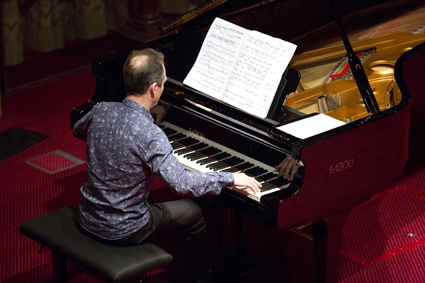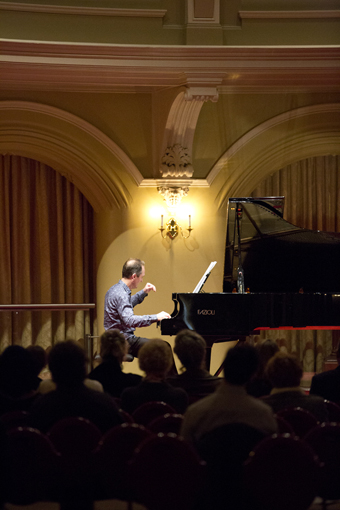 |
Michael Kieran Harvey, THNMF2013 photo Brad Serls |
In the centre of Harvey’s own Psychosonata is a traditional sonata form with classically ‘pianistic’ lyrical flights and arpeggios representing the orderly, supposedly ‘healthy’ mind. This structure is obscured beneath a texture of fast and dissonant runs; thundering chords and stubborn, persistent lines built out of an obsessively recalculated nine-value series representing the supposedly ‘psychotic’ mind. In composing this musical palimpsest, Harvey drew inspiration from the paintings of Frank Auerbach, where extreme psychological states are represented by complex agglomerations of paint over otherwise traditional portraits. I like to think that Harvey’s resultant musical surface shows thought not so much as order and disorder, but as variations in density. As both Harvey and Elliott Gyger show at the end of their works, a dissonant chord can connote ‘orderliness’ if played slowly and softly across several octaves.
 |
Michael Kieran Harvey, THNMF2013 photo Brad Serls |
In the Prelude, Gyger transcribes the nine lines of the inscription above the gates of hell into dense chords rapidly alternating with rolled clusters. The two gestures also conjure images of the wasps and maggots chasing those who committed neither good nor bad deeds in hell’s “vestibule.”
The river of water crossed by the ferryman Charon is depicted by descending passages in racing, machinic rhythms. Rather than the common ‘water’ effect of undulating, pointillist glistening, the regularity of Gyger’s gestures creates a sound like a pixelated image or a monophonic, 8-bit sound effect from an early-1990s computer game. This effect is punctuated by tones ‘dropped’ into the stream, unleashing a similarly pixelated ‘splash’ of notes.
The lustful, blown about by the winds in hell as they were by their passions in life, are depicted in a flurry of sensual modal devices. Whole-tone harmonies, snatches of pentatonic melodies, open fifths and soft, smoky chords twist around and past each other over the keyboard.
As the wrathful fight each other on the surface and the slothful sulk deep in the river Styx, a languid bass ostinato contrasts with wet, slapping chords.
The river of boiling blood is depicted by the same material as the river of water, but this time furiously frothing and bubbling across the whole range of the piano.
Less iconic scenes—such as the first circle of hell where virtuous non-Christians live in an imperfect heaven—are harder to decipher. The “ten trenches of fraud” is used as an opportunity to reprise material from the rest of the cycle in a series of variations.
All of the punishments in Dante’s Inferno have a poetic justice about them, such as the avaricious or miserly who must duel by pushing enormous weights against each other. As a non-signifying art form, can music express the poetic justice of Dante’s punishments? Perhaps only in the sheer difficulty of playing the piece itself.
Tura Totally Huge New Music Festival, A Celebration of New Australian Piano Music, Michael Kieran Harvey, Government House Ballroom, 11 Sept
© Matthew Lorenzon; for permission to reproduce apply to [email protected]








 back
back